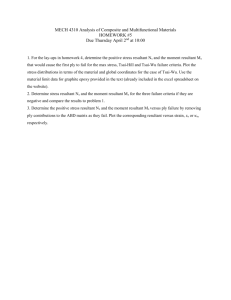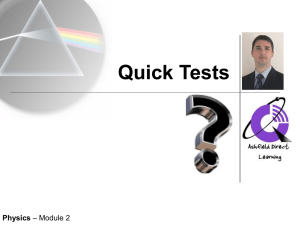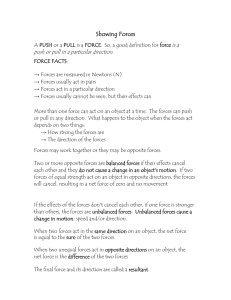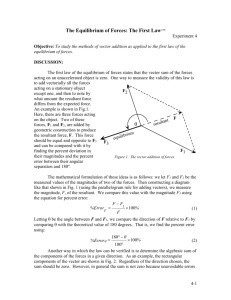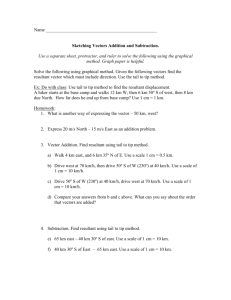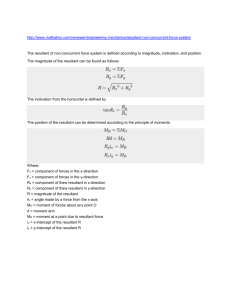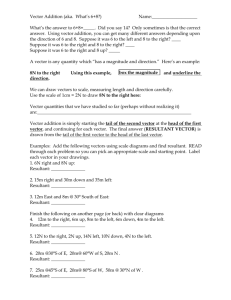2 Force Vectors
advertisement
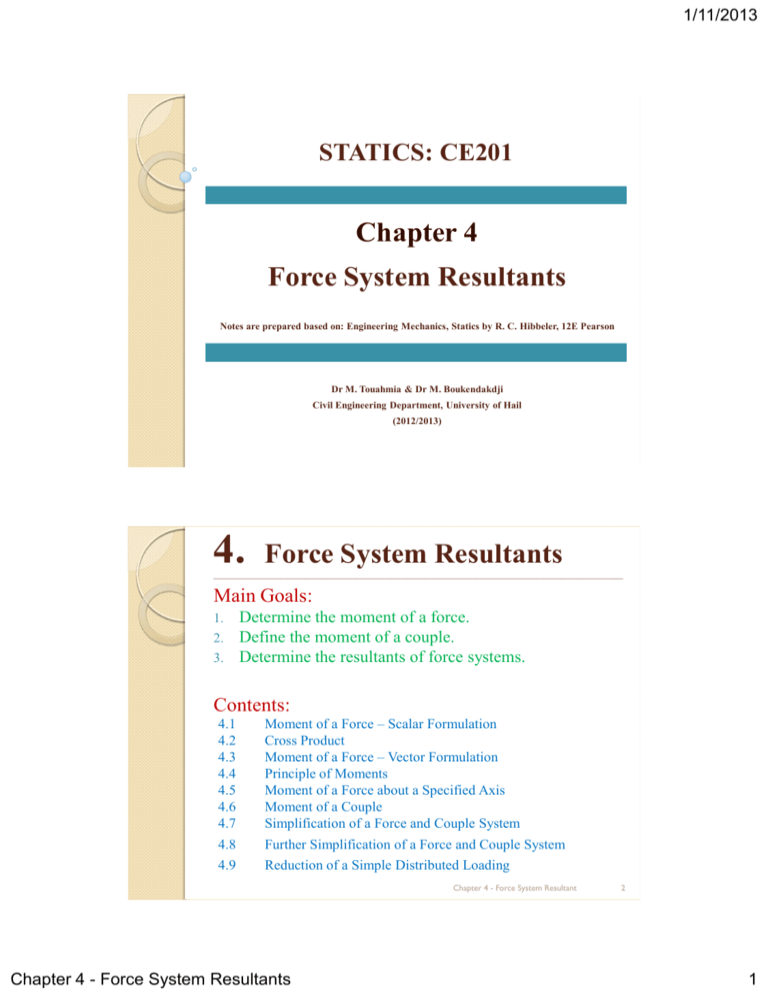
1/11/2013 STATICS: CE201 Chapter 4 Force System Resultants Notes are prepared based on: Engineering Mechanics, Statics by R. C. Hibbeler, 12E Pearson Dr M. Touahmia & Dr M. Boukendakdji Civil Engineering Department, University of Hail (2012/2013) 4. Force System Resultants ________________________________________________________________________________________________________________________________________________ Main Goals: 1. 2. 3. Determine the moment of a force. Define the moment of a couple. Determine the resultants of force systems. Contents: 4.1 4.2 4.3 4.4 4.5 4.6 4.7 Moment of a Force – Scalar Formulation Cross Product Moment of a Force – Vector Formulation Principle of Moments Moment of a Force about a Specified Axis Moment of a Couple Simplification of a Force and Couple System 4.8 Further Simplification of a Force and Couple System 4.9 Reduction of a Simple Distributed Loading Chapter 4 - Force System Resultant Chapter 4 - Force System Resultants 2 1 1/11/2013 4.1 Moment of a Force – Scalar Formulation When a force is applied to a body it will produce a tendency for the body to rotate about a point or axis that is not on the line of action of the force. This tendency to rotate is called “moment of a force” or simply the moment. Chapter 4 - Force System Resultant 4.1 3 Moment of a Force – Scalar Formulation For example, consider a wrench used to unscrew the bolt in the figure. If a force is applied to the handle of the wrench it will tend to turn the bolt about point O (or the z axis). The magnitude of the moment is directly proportional to the magnitude of F and the perpendicular distance or moment arm d. Chapter 4 - Force System Resultant Chapter 4 - Force System Resultants 4 2 1/11/2013 4.1 Moment of a Force – Scalar Formulation The larger the force or the longer the moment arm, the greater the moment or turning effect. NOTE: If force F is applied at an angle 90 then it will be more difficult to turn the bolt since the moment arm d d sin will be smaller than d. If F is applied along the wrench, its moment arm will be zero and as a result, the moment of F about O will be zero also. Chapter 4 - Force System Resultant 4.1 5 Moment of a Force – Scalar Formulation The moment M O of a force F about a point O is defined as the vector product of F and d, where d is the perpendicular distance from O to the line of action of the force F. Clearly the moment is a vector and has both: magnitude and direction. Magnitude: The magnitude of the moment determined from: M O is M O Fd Units: N.m; kN.m; N.mm Chapter 4 - Force System Resultant Chapter 4 - Force System Resultants 6 3 1/11/2013 4.1 Moment of a Force – Scalar Formulation Direction: The right-hand rule is used to establish the sense of direction of the moment M O . The moment of a force will be positive if it is directed along the +z axis and will be negative if it is directed along the –z axis. Chapter 4 - Force System Resultant 4.1 7 Moment of a Force – Scalar Formulation Resultant Moment: The Resultant Moment M R O about point O (the z axis) can be determined by finding the algebraic sum of the moments caused by all the forces in the system: M R O Fd As a convention, we will generally consider positive moments (+) as counterclockwise and negative moments (-) as clockwise. M R O Fd F1d1 F2 d 2 F3 d 3 Chapter 4 - Force System Resultant Chapter 4 - Force System Resultants 8 4 1/11/2013 Example 1 For each case below, determine the moment of the force about point O. Answer M O Fd M O 100 N2 m 200 N.m Answer M O 50 N0.75 m 37.5 N.m Chapter 4 - Force System Resultant 9 Example 1 Answer M O 40 kN 4m 2 cos 30 o m 229 kN.m Answer M O 60 kN 1sin 45 o m 229 kN.m Chapter 4 - Force System Resultant Chapter 4 - Force System Resultants 10 5 1/11/2013 Example 2 Determine the resultant moment of the four forces acting on the rod about point O. Chapter 4 - Force System Resultant 11 Solution 2 Assuming that positive moments (+) are in the counterclockwise: M R O Fd M RO 50 N 2 m 60 N 0 20 N 3 sin 30o m 40 N 4 m 3 cos 30o m 334 N.m Chapter 4 - Force System Resultant Chapter 4 - Force System Resultants 12 6 1/11/2013 4.2 Cross Product The cross product of two vectors A and B yields the vector C written: C A B Magnitude: The magnitude of C is defined as the product of the magnitudes of A and B and the sine of the angle θ between their tails: C AB sin Direction: Vector C has a direction perpendicular to the plane containing A and B and is specified by the right-hand rule: C A B AB sin uC u C defines the direction of C Chapter 4 - Force System Resultant 13 Laws of Operation: Commutative law: The commutative law is not valid AB B A A B B A C If the cross product is multiplied by a scalar a, it obeys the associative law: aA B aA B A aB A Ba The vector cross product also obeys the distributive law of addition: A B D A B A D Chapter 4 - Force System Resultant Chapter 4 - Force System Resultants 14 7 1/11/2013 Cross products of unit vectors (i, j, k): The direction is determined using the right hand rule. As shown in the diagram, for this case the direction is k and the Magnitude is: | i j |=(1)(1)(sin90°) = (1)(1)(1)=1 so: i j = (1) k = k and: ij=k i k = -j ii=0 jk=i j i = -k jj=0 ki=j k j = -i kk=0 Alphabetical order + Chapter 4 - Force System Resultant 15 Cartesian Vector Formulation The cross product of two vectors A and B expressed in Cartesian vector form is: A B Ax i Ay j Az k B x i B y j B z k Ax B x i i Ax B y i j Ax B z i k Ay B x j i Ay B y j j Ay B z j k Az B x k i Az B y k j Az B z k k A B Ay Bz Az B y i Ax Bz Az Bx j Ax B y Ay Bx k Chapter 4 - Force System Resultant Chapter 4 - Force System Resultants 16 8 1/11/2013 Cartesian Vector Formulation This equation may also be written in a more compact determinant form as : The three minors can be generated with the following scheme: Adding the results yields the expanded form of A B : A B Ay Bz Az B y i Ax Bz Az Bx j Ax B y Ay Bx k Chapter 4 - Force System Resultant 17 4.3 Moment of a Force – Vector Formulation The moment of a force F about point O, or about an axis passing through O and perpendicular to the plane containing O can be expressed using the vector cross product: MO r F where r is the position vector from O to any point on the line of action of F. Chapter 4 - Force System Resultant Chapter 4 - Force System Resultants 18 9 1/11/2013 4.3 Moment of a Force – Vector Formulation Magnitude: M O rF sin F r sin Fd Direction: The direction of Mo follows the right-hand rule as it applies to the cross product, “r cross F”. Chapter 4 - Force System Resultant 19 4.3 Moment of a Force – Vector Formulation Principle of Transmissibility: We can use any position vector r measured from point O to any point on the line of action of the force F: M O r1 F r2 F r3 F Chapter 4 - Force System Resultant Chapter 4 - Force System Resultants 20 10 1/11/2013 4.3 Moment of a Force – Vector Formulation Resultant Moment of a System of Forces: If a body is subjected to a system of forces, the resultant moment of all the forces about point O is equal to the vector addition of the moment of each force: n M RO ri Fi i 1 Chapter 4 - Force System Resultant 21 Example 3 Determine the moment MO produced by the force F about point O. Express the result as a Cartesian vector. Chapter 4 - Force System Resultant Chapter 4 - Force System Resultants 22 11 1/11/2013 Solution 3 As shown in the figure, either rA or rB can be used to determine the moment about O: rA 12 k m rB 4 i 12 j m F expressed as Cartesian vector: F Fu AB The direction of the unit vector uAB can be determined from the position Vector rAB which extends from A to B. rAB 4 i 12 j-12 k m Chapter 4 - Force System Resultant 23 Solution 3 The magnitude of rAB which represents the length of AB is: 2 2 2 rAB 4 m 12 m 12 m Forming the unit vector that defines The direction of both rAB and F, we have: u AB rAB rAB 4i 12 j 12k 4 m 12 m2 12 m2 2 4i 12 j 12k F Fu AB 2 kN 2 4 m 12 m 2 12 m 2 0.4588 i 1.376 j 1.376 k kN Chapter 4 - Force System Resultant Chapter 4 - Force System Resultants 24 12 1/11/2013 Solution 3 The moment about O: M O rA F or M O rB F rA 12 k m, rB 4 i 12 j m , F 0.5488 i 1.376 j 1.376 k kN OR Chapter 4 - Force System Resultant 25 Example 4 Two forces act on the rod shown below. Determine the resultant moment they create about the flange at O. Express the results as a Cartesian vector. Chapter 4 - Force System Resultant Chapter 4 - Force System Resultants 26 13 1/11/2013 Solution 4 Position vectors rA and rB are directed from point O to each force: rA 5 j m rB 4 i 5 j 2 k m The resultant moment about O is: n M RO ri Fi rA F1 rB F2 i 1 M RO rA F1 rB F2 i j k i j k 0 5 0 4 5 2 60 40 20 80 40 30 Chapter 4 - Force System Resultant 27 Solution 4 The resultant moment about O is: The coordinate direction angles were determined from the unit vector for M R O The two forces tend to cause the rod to rotate about the moment axis in the manner shown by the curl indicate on the moment vector. Chapter 4 - Force System Resultant Chapter 4 - Force System Resultants 28 14 1/11/2013 4.3 Principle of Moments Varignon’s Theorem: The moment of a force about a point is equal to the sum of the moments of the components of the force about the point. For example, consider the moment of the force F which has two components F1 and F2, therefore: F F1 F2 Then, the moment of F about O is: M O r F r F1 F2 r F1 r F2 Chapter 4 - Force System Resultant 29 4.3 Principle of Moments For two-dimensional problems (2D), we can use the principle of moments by resolving the force into its rectangular components and then determine the moment using a scalar analysis: M F y F x O x y This method is generally easier than finding the same moment using: M O Fd Chapter 4 - Force System Resultant Chapter 4 - Force System Resultants 30 15 1/11/2013 Example 3 Determine the moment of the force about point O. Chapter 4 - Force System Resultant 31 Example 3-(I) The moment arm d can be found from trigonometry: d 3 msin 75 2.898 m M O Fd 5 kN2.898 m 14.5 kN.m The force tends to rotate clockwise about O, the moment is directed into the page . Chapter 4 - Force System Resultant Chapter 4 - Force System Resultants 32 16 1/11/2013 Solution 3-(II) We can apply the principle of moments by resolving the force into its rectangular components and then determine the moment using a scalar analysis: M O Fx d y Fy d x M O 5 cos 45 kN 3 sin 30 m 5 sin 45 kN 3 cos 30 m 14.5 kN.m 14.5 kN.m Chapter 4 - Force System Resultant 33 Solution 3-(III) The x and y axes can be set parallel and perpendicular to the rod’s axis. Fx produces no moment about point O since its line of action passes through this point: M O Fy d x M O 5 sin 75 kN 3 m 14.5 kN.m M O 14.5 kN.m Chapter 4 - Force System Resultant Chapter 4 - Force System Resultants 34 17 1/11/2013 Example 4 The force F acts at the end of the angle bracket. Determine the moment of F about point O. Chapter 4 - Force System Resultant 35 Solution 4-(I) Scalar Analysis F can be resolved into its x and y components: Fx 400 sin 30 Fy 400 cos 30 M O Fx y Fy x M O 400 sin 30 N 0.2 m 400 cos 30 N 0.4 m 98.6 N.m 98.6 N.m Chapter 4 - Force System Resultant Chapter 4 - Force System Resultants 36 18 1/11/2013 Solution 4-(II) Vector Analysis Using a Cartesian vector analysis, the force F and the position vector r can be written as: F 400 sin 30 i 400 cos 30 j N 200.0 i 346.4 j N r 0.4 i 0.2 j m i M O r F 0.4 j 0.2 k 0 200.0 346.4 0 M O 0 i 0 j 0.4 346.4 0.2200.0 k 98.6 k N.m Chapter 4 - Force System Resultant 4.6 37 Moment of a Couple A couple is defined as two parallel forces that have the same magnitude, but opposite directions, and are separated by a perpendicular distance d. Since the resultant force is zero, the only effect of a couple is to produce a rotation or tendency of rotation in a specified direction. Chapter 4 - Force System Resultant Chapter 4 - Force System Resultants 38 19 1/11/2013 4.6 Moment of a Couple The moment produced by a couple is called a couple moment. We can determine its value by finding the sum of the moments of both couple force about any arbitrary point. The position vectors rA and rB are directed from point O to points A and B lying on the line of action –F and F. The couple moment M about O is therefore: M (r F) (r F) r r F B A B However, rB rA r Therefore: or A r rB rA M rF Chapter 4 - Force System Resultant 4.6 39 Moment of a Couple Scalar Formulation: The moment of a couple, M, is defined as having a magnitude of: M Fd Vector Formulation: The moment of a couple can also be expressed by the vector cross product using: M rF where r is directed from any point on the line of action of one of the forces to any point on the line of action of the other force F. Chapter 4 - Force System Resultant Chapter 4 - Force System Resultants 40 20 1/11/2013 4.6 Moment of a Couple Equivalent Couples: If two couples produce a moment with the same magnitude and direction, then these two couples are equivalent. M 30 N0.4 m 12 N.m M 40 N0.3 m 12 N.m The two couple moments shown in the figure are equivalent because each couple moment has a magnitude of 12 N.m and each is directed into the plane of the page. Chapter 4 - Force System Resultant 4.6 41 Moment of a Couple Resultant Couple Moment: It is simply the vector sum of all the couple moments of the system. M R r F For example, consider the couple moments M1 and M2 acting on the pipe. We can join their tails at any arbitrary point and find the resultant couple moment. M R M1 M 2 Chapter 4 - Force System Resultant Chapter 4 - Force System Resultants 42 21 1/11/2013 Example 5 Determine the resultant couple moment of the three couples acting on the plate. Chapter 4 - Force System Resultant 43 Solution 5 Considering counterclockwise couple moments as positive (+), we have: M R M F1 d1 F2 d 2 F3 d 3 M R 200 N 0.4 m 450 N 0.3 m 300 N 0.5 m 95 N.m 95 N.m Chapter 4 - Force System Resultant Chapter 4 - Force System Resultants 44 22 1/11/2013 Example 6 Determine the magnitude and direction of the couple moment acting on the gear. Chapter 4 - Force System Resultant 45 Solution 6 Resolving each force into its components. The couple moment can be determined by summing the moments of these force components about any point (For example the center O or point A): M MO 600 cos 30 0.2 600 sin 30 0.2 43.9 N.m OR M MA 600 cos 30 0.2 600 sin 30 0.2 43.9 N.m Chapter 4 - Force System Resultant Chapter 4 - Force System Resultants 46 23 1/11/2013 Solution 6 The same result can also be obtained using: M Fd where d is the perpendicular distance between the lines of action of the couple forces. However, the computation for d is more involved. Chapter 4 - Force System Resultant 47 4.7 Simplification of a Force and Couple System Sometimes it is convenient to reduce a system of forces and couple moments acting on a body to a simpler form by replacing it with an equivalent system. Example: Chapter 4 - Force System Resultant Chapter 4 - Force System Resultants 48 24 1/11/2013 System of Forces and Couple Moments: A system of several forces and couple moments acting on a body can be reduced to an equivalent single resultant force acting at a point O and a resultant couple moment. Chapter 4 - Force System Resultant 49 System of Forces and Couple Moments: Example: In the figure, point O is not on the line of action of F1 and so this force can be moved to point O provided a couple moment M1 r1 F1 is added to the body. Similarly, the couple moment M 2 r2 F2 should be added to the body when we move F2 to point O. Finally, since the couple moment M is a free vector, it can just be moved to point O. Chapter 4 - Force System Resultant Chapter 4 - Force System Resultants 50 25 1/11/2013 System of Forces and Couple Moments: If we sum the forces and couple moments, we obtain the resultant force and the resultant couple moment: M R O M M1 M 2 FR F1 F2 Chapter 4 - Force System Resultant 51 System of Forces and Couple Moments: We can generalize this method of reducing a force and couple system to an equivalent resultant forces FR acting at point O and a resultant couple moment (MR)O by using the following equations: FR F M R O M O M If the force system lies in the x-y plane and any couple moments are perpendicular to this plan, then the above equations reduce to the three scalar equations: FR x Fx FR y Fy M R O M O M Chapter 4 - Force System Resultant Chapter 4 - Force System Resultants 52 26 1/11/2013 Example 7 Replace the force and couple system by an equivalent resultant force and couple moment acting at point O. Chapter 4 - Force System Resultant 53 Solution 7 Force Summation: The 3 kN and 5 kN forces are resolved into their x and y components as shown below. We have: FR x Fx 3 kN cos 30 3 5 kN 5.598 kN 5 FR y Fy 3 kN sin 30 FR FRx 2 FRy 2 4 5 kN 4 kN 6.50 kN 5 5.5982 6.502 8.58 kN FR y 6.50 o tan 1 49.3 5.598 FR x tan 1 Chapter 4 - Force System Resultant Chapter 4 - Force System Resultants 54 27 1/11/2013 Solution 7 Moment Summation: The moments of 3 kN and 5 kN about point O will be determined using their x and y components. We have: M R O M O 3 kN sin 30 0.2 m 3 kN cos 30 0.1 m 3 4 5 kN 0.1 m 5 kN 0.5 m 5 5 4 kN 0.2 m 2.46 kN.m 2.46 kN Chapter 4 - Force System Resultant 55 Example 8 Replace the force and couple system acting on the member by an equivalent resultant force and couple moment acting at point O. Chapter 4 - Force System Resultant Chapter 4 - Force System Resultants 56 28 1/11/2013 Solution 8 Force Summation: Since the couple forces of 200 N are equal but opposite, they produce zero resultant force. The 500 N force is resolved into its x and y components: FR x Fx F R y FR 3 500 kN 300 N 5 4 F 500 N 750 350 N 5 y FR x 2 FR 2 y 300 N2 350 N2 462 N FR y 350 N tan 1 49.4 F 300 N R x tan 1 Chapter 4 - Force System Resultant 57 Solution 8 Moment Summation: Since the couple moment is a free vector, it can act at any point on the member, then: M R O M O M c 500 N 4 2.5 N 500 N 3 1 m 5 5 750 N 1.25 m 200 N 1 m 37.5 N.m 37.5 N.m Chapter 4 - Force System Resultant Chapter 4 - Force System Resultants 58 29 1/11/2013 4.8 Reduction of a Simple Distributed Loading Sometimes, a body may be subjected to a loading that is distributed over its surface. For example: The pressure of the wind on the face of a sign. The pressure of water within a tank. The weight of sand on the floor of a storage container. The pressure exerted at each point on the surface indicates the intensity of the loading. It is measured using Pascals Pa (N/m2). Chapter 4 - Force System Resultant 59 Uniform Loadings Along a Single Axis: The most common type of distributed loading encountered in engineering practice is generally uniform along a single axis. Example: The beam (or plate) that has a constant width and is subjected to a pressure loading that varies only along the x axis. This loading can be described by the 2 function: p p(x) N/m We can replace this coplanar parallel force system with a single equivalent resultant force FR acting at a specific location on the beam. Chapter 4 - Force System Resultant Chapter 4 - Force System Resultants 60 30 1/11/2013 Magnitude of Resultant Force: The magnitude of FR is equivalent to the sum of all the forces in the system: FR F Integration must be used since there is an infinite number of parallel forces dF acting on the beam. Since dF is acting on an element of length dx, and w(x) is a force per unit length, Then: dF wx dx dA FR wx dx dA A L A Therefore, the magnitude of the resultant force is equal to the total area A under the loading diagram. Chapter 4 - Force System Resultant 61 Location of Resultant Force: The location x of the line of action of FR can be determined by equating the moments of the force resultant and the parallel force distribution about point O. dF produces a moment of: xdF xwx dx Then for the entire length: M R O M O xFR xwx dx L x xwx dx xdA wx dx dA L L A A Chapter 4 - Force System Resultant Chapter 4 - Force System Resultants 62 31 1/11/2013 Example 9 Determine the magnitude and location of the equivalent resultant force acting on the shaft. Chapter 4 - Force System Resultant 63 Solution 9 Since w = w(x) is given, this problem will be solved by integration. The differential element has an area: dA wdx 60x 2 dx FR dA A x3 2 60x dx 60 0 3 2m xdA x60 x dx 2m 2 x A dA 0 160 N 2m 23 0 60 160 N 0 3 3 x4 2 m 24 04 60 60 4 4 0 4 160 N 160 N 1.5 m A Chapter 4 - Force System Resultant Chapter 4 - Force System Resultants 64 32 1/11/2013 Example 10 The granular material exerts the distributed loading on the beam. Determine the magnitude and location of the equivalent resultant of this load. Chapter 4 - Force System Resultant 65 Solution 10 The area of the loading diagram is a trapezoid. It can be divided into a rectangular and triangular loading. F1 1 9 m50 kN/m 225 kN 2 F2 9 m50 kN/m 450 kN x1 1 9 m 3 m 3 x2 1 9 m 4.5 m 2 Chapter 4 - Force System Resultant Chapter 4 - Force System Resultants 66 33 1/11/2013 Solution 10 The two parallel forces F1 and F2 can be reduced to a single resultant force FR. The magnitude of FR is: FR F FR 225 450 675 kN We can find the location of F with reference to point A: M R A M A x675 3225 4.5450 x 4m Chapter 4 - Force System Resultant Chapter 4 - Force System Resultants 67 34

